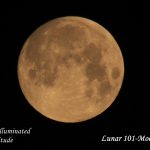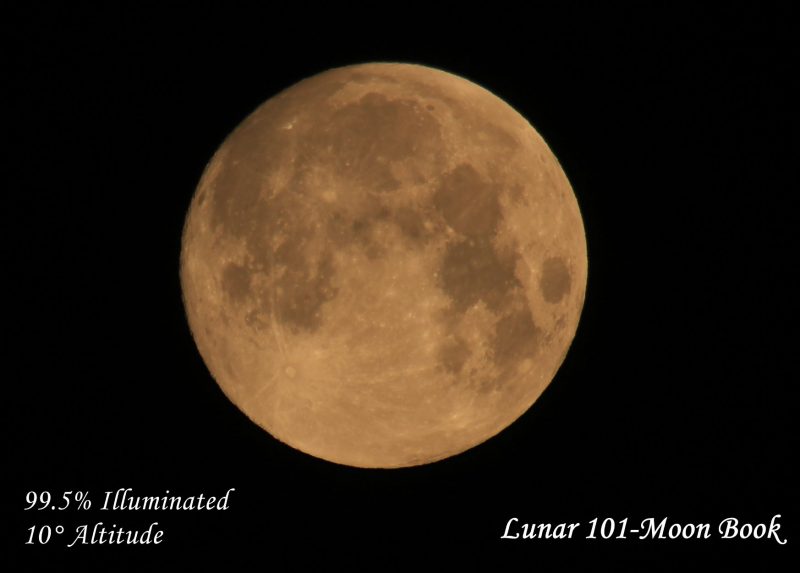

Steven A. Sweet of Lunar 101 Moon Book caught the nearly full moon on the morning of March 1, 2018, 5:48 a.m., Toronto, Ontario, Canada. He likely caught it setting; that’s why it looks yellowish.
Every full moon is (more or less) opposite the sun from Earth. It rises in the east as the sun sets in the west, ascends to its highest point in the sky in the middle of the night, and sets in the west around dawn. The March 1-2, 2018 full moon is the first of two full moons this month. The second one – on March 31 – will be a Blue Moon.
The moon is said to be precisely full at the exact moment that it’s opposite the sun in ecliptic or celestial longitude. This full moon instant comes on March 2, 2018, at 00:51 Universal Time. For North America and Hawaii, that means the moon turns precisely full this evening – on March 1, 2018 – at 8:51 p.m. AST, 7:51 p.m. EST, 6:51 p.m. CST, 5:51 p.m. MST, 4:51 p.m. PST, 3:51 p.m AKST and 2:51 p.m. HST.
For both the Northern and Southern Hemispheres, the first full moon of March 2018 presents the third of three full moons to occur between the December 2017 solstice and the March 2018 equinox.
It’s the Northern Hemisphere’s last full moon of winter and Southern Hemisphere’s last full moon of summer.
The second of the two March 2018 full moons – March 31, 2018 – will be the first full moon of spring for the Northern Hemisphere and first full moon of autumn for the Southern Hemisphere.
In most years, the Christian celebration of Easter happens on the first Sunday after the first full moon of a Northern Hemisphere spring. Sure enough, Easter will come on Sunday, April 1, 2018, the day after the full moon on Saturday, March 31, 2018.
For the Southern Hemisphere, the Blue Moon – the the second full moon of March 2018 – will also be their Harvest Moon, the closest full moon to the autumn equinox.
Read more about the history of the name Blue Moon
As the moon orbits Earth, it changes phase in an orderly way. Follow these links to understand the various phases of the moon.
Four keys to understanding moon phases
Where’s the moon? Waxing crescent
Where’s the moon? First quarter
Where’s the moon? Waxing gibbous
What’s special about a full moon?
Where’s the moon? Waning gibbous
Where’s the moon? Last quarter
Where’s the moon? Waning crescent
Where’s the moon? New phase
Bottom line: A full moon looks full because it’s opposite Earth from the sun, showing us its fully lighted hemisphere or day side. The March 1-2, 2018 full moon is the first of two full moons this month.
Can you tell me the full moon names?
from EarthSky http://ift.tt/1iAoPbQ


Steven A. Sweet of Lunar 101 Moon Book caught the nearly full moon on the morning of March 1, 2018, 5:48 a.m., Toronto, Ontario, Canada. He likely caught it setting; that’s why it looks yellowish.
Every full moon is (more or less) opposite the sun from Earth. It rises in the east as the sun sets in the west, ascends to its highest point in the sky in the middle of the night, and sets in the west around dawn. The March 1-2, 2018 full moon is the first of two full moons this month. The second one – on March 31 – will be a Blue Moon.
The moon is said to be precisely full at the exact moment that it’s opposite the sun in ecliptic or celestial longitude. This full moon instant comes on March 2, 2018, at 00:51 Universal Time. For North America and Hawaii, that means the moon turns precisely full this evening – on March 1, 2018 – at 8:51 p.m. AST, 7:51 p.m. EST, 6:51 p.m. CST, 5:51 p.m. MST, 4:51 p.m. PST, 3:51 p.m AKST and 2:51 p.m. HST.
For both the Northern and Southern Hemispheres, the first full moon of March 2018 presents the third of three full moons to occur between the December 2017 solstice and the March 2018 equinox.
It’s the Northern Hemisphere’s last full moon of winter and Southern Hemisphere’s last full moon of summer.
The second of the two March 2018 full moons – March 31, 2018 – will be the first full moon of spring for the Northern Hemisphere and first full moon of autumn for the Southern Hemisphere.
In most years, the Christian celebration of Easter happens on the first Sunday after the first full moon of a Northern Hemisphere spring. Sure enough, Easter will come on Sunday, April 1, 2018, the day after the full moon on Saturday, March 31, 2018.
For the Southern Hemisphere, the Blue Moon – the the second full moon of March 2018 – will also be their Harvest Moon, the closest full moon to the autumn equinox.
Read more about the history of the name Blue Moon
As the moon orbits Earth, it changes phase in an orderly way. Follow these links to understand the various phases of the moon.
Four keys to understanding moon phases
Where’s the moon? Waxing crescent
Where’s the moon? First quarter
Where’s the moon? Waxing gibbous
What’s special about a full moon?
Where’s the moon? Waning gibbous
Where’s the moon? Last quarter
Where’s the moon? Waning crescent
Where’s the moon? New phase
Bottom line: A full moon looks full because it’s opposite Earth from the sun, showing us its fully lighted hemisphere or day side. The March 1-2, 2018 full moon is the first of two full moons this month.
Can you tell me the full moon names?
from EarthSky http://ift.tt/1iAoPbQ

Aucun commentaire:
Enregistrer un commentaire